WORLD CLASS COACHING
Club Curriculum Fun Training Games
By Tony Englund
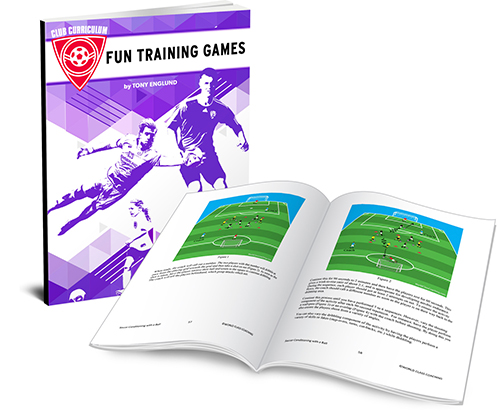
TABLE OF CONTENTS
Part Two
DRIBBLING GAMES
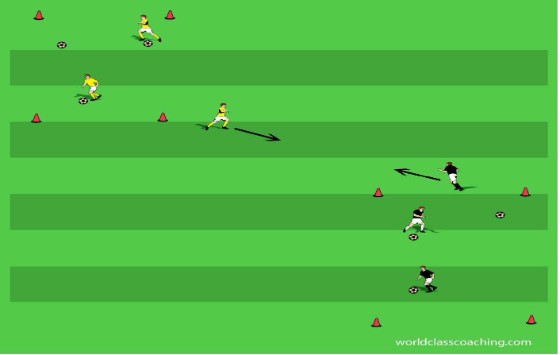
Grid tag with ball - 2 15x15 yard grids
Each player has a ball. Divide the team into two groups, putting one group into each grid. At a signal from the coach, one player on each team leaves her ball and runs into the opposing grid. She stays there until she can tag one of the other team’s players and then sprints back to her own grid. The first player to return earns a point for her team. Give each player a chance to be the runner.
Tail tag with ball - 20X20 yard grid
Each player has a ball at their feet and a scrimmage vest tucked into the back of their shorts (‘tail’). Players dribble around the area trying to tug out other players’ tails. If a player loses her tail, she dribbles to the edge of the grid and fixes her tail, then re-joins play. Play for three minutes.
Hospital tag - 20x20 yard grid
Each player has a ball. This is a tag and dribbling game that challenges players to get creative tags on other players while also keeping their ball and avoiding being tagged. When a player is tagged once, she must “cover” the “wound” with one hand. The second “wound” is covered with the other hand and it is worth noting that this player can no longer tag anyone else. With a third tag, the player must go to the “hospital,” which is the perimeter of the grid. There, the player does six dribbling touches at which point she is “healed” and may reenter play. Encourage players to be creative with their tags (i.e. a lower leg tag creates a funny-looking dribble) and to be safe in applying tags (soft tags and avoid the face, etc.). Play for three minutes.
Statue Tag - 20x20 yard grid
Two defenders stand outside the grid to start. All other players have a ball and spread out inside the grid. At a signal from the coach, the defenders enter the grid and attempt to tag the dribblers. If a dribbler gets tagged, she stops and holds her ball above her head. Statues can be revived by a dribbler with a dribble/pass between the statues’ legs. The defenders win if all players become statues within one minute. The dribblers win if anyone is still active. Play several rounds to allow everyone to be a defender.
Corner tag - 6x6 yard grids
Players start at each corner of the grid. At two opposite corners, the players have a ball. Those players pass the ball to their right and then follow their pass. The receiving players dribble counter-clockwise (continuing the movement to the right) to the next corner, where they pass to their right and the play continues. Encourage players, once they understand the pattern, to try to catch up to the other ball by playing a bit faster. Can they tag the person who is next in the sequence?
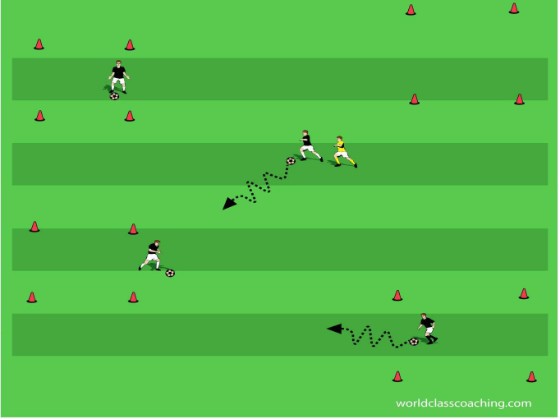
Island tag - ½ field
Create multiple, small ‘islands’ using cones to outline the areas. One person acts as the ‘shark,’ running about trying to tag players who are not on islands. Those players each have a ball and they try to dribble from island to island, trying to avoid being ‘bitten’ by the shark. Anyone tagged by a shark must do four dribbling touches in place and then they are ‘healed’ and can continue to play. If players stay on the islands, the coach can call ‘land shark!’ at which time the shark can go onto the islands for five seconds.
Freeze tag - 20x20 yard grid
One player is ‘it.’ The remainder all have a ball and they dribble around the area. The ‘it’ player tags dribblers, who then have to freeze, spread their feet, and pick up their ball and hold it above their head. If an active player can pass the ball between the feet of a frozen player, that player is ‘thawed’ and can continue playing. If the ‘it’ player can freeze all of the dribblers she wins. Alternate ‘it’ players every two minutes.
Knockout - 20x20 yard grid
Each player has a ball. Players dribble around the grid and attempt to knock the balls dribbled by other players out of the grid while keeping their own ball. This is a game that is commonly used to teach shielding the ball (keeping the ball on the outside of the away foot when confronted by an opponent) and also poke tackling (using the front of the foot to tap the ball off of the dribbling player), and the key points of coaching for young players include spatial awareness, thoughtful dribbling, and dealing with a opponent in tight space. When a player’s ball is knocked out of the grid, they are not eliminated. Rather, they must sprint after the ball and then return to the perimeter of the grid, where they perform six dribbling touches and then return to the game. Players should keep track of the number of balls they knock out of the grid and also the number of times their own ball is knocked out. Play for three minutes and then check scores.
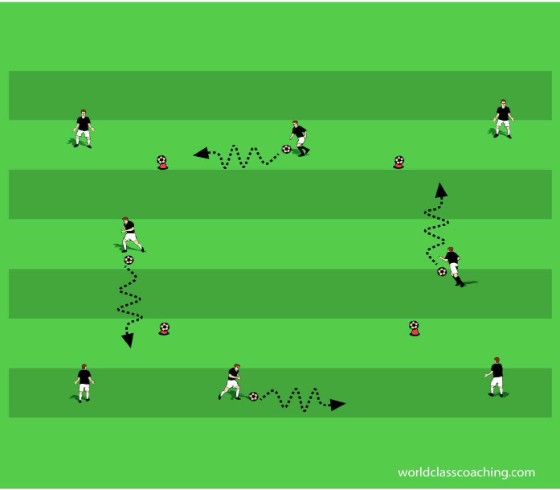
Dribbling races - 10x10 yard grids
Players are organized in pairs with two balls for each group. Put each pair at the corner of a grid. One ball is place on top of the disc cone in the corner. The player whose ball is on the cone is resting and cheering for her partner, and she should take a knee three yards outside the grid near the corner. The other player is the racer. All racers start at the signal from the coach. Each player must dribble around the entire perimeter of the grid back to her starting point and then use her ball to tap her partner’s ball off of the cone. Determine a winner in each race and then switch roles and race again.
Variations
• All dribble clockwise.
• All dribble counter –clockwise.
• At each corner, the racer must pass her ball inside the corner marker and then she runs around the outside of the marker and catches up with the ball and continues to dribble around the perimeter (run clockwise and counter-clockwise).
Check points at the end of the sequence to determine a winner.
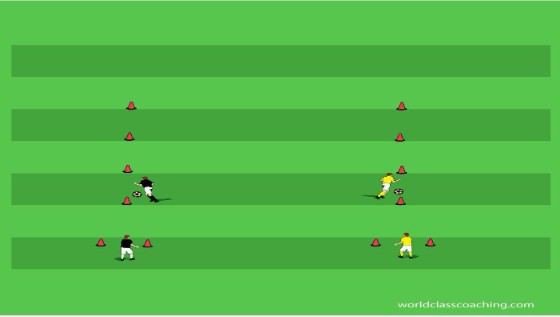
Relay races - ¼ field
Players work in pairs or larger numbers, depending on the preference of the coach. Relays can take many forms, but in essence involve a sense of team purpose and time pressure.
Examples
• Players dribble around a cone or series of cones and back to the start point.
• Players dribble around a cone their first run, then a more distant cone on their second run, etc.
• Players dribble a complete circle around each cone.
• Players weave through a set of cones and run back to the start.
• Players perform a simple move at each cone (i.e. turn the ball with the inside of the foot or use a pull-back to change directions.
More variations can involve restrictions regarding the foot used to dribble or the surface (inside/outside) to be used.
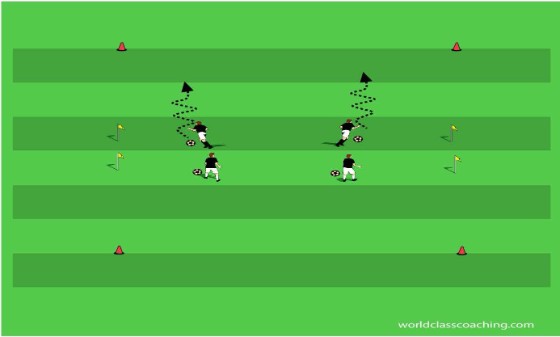
Players Crows and cranes - ½ fieldwork in pairs, and each player has a ball. Place the players along two cone lines running across the center of the field area and five yards apart. One member of each pair is on each line and they are facing the coach, who stands at the side of the grid. One player is a “crow” and the other is a “crane.” The coach calls out either name and the group that is chosen dribbles their ball at top speed to the nearest end line. The other group, meanwhile, chases them, dribbling their soccer balls and trying to get close enough to tag their partner. After each race, players jog back to their starting point. This game teaches speed dribbling and also dribbling with some pressure. The ideal surface here is the laces (allows players to keep their running form and speed), but that is of minimal concern with young players. The coach can instruct players to use a longer first touch to get themselves going and then shorter touches as they near the finish line.
Variations
• To win the race, the player must stop the ball on the endline (emphasizes control at the end of the dribbling run).
• The chasing group does not have to tag their partners, but rather tries to beat them to the endline.
• The chasing group does not need to dribble their ball.
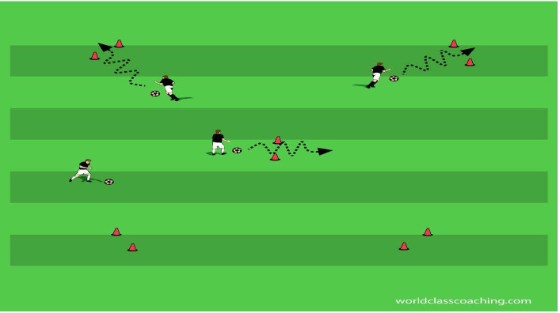
Many Goals Dribbling - 20x30 yard grid
Create a grid with 6 small cone goals spread randomly across the area. Players work in pairs with one player in possession to start. Explain that the purpose of the game is to win or keep possession of the ball from one’s partner and then dribble through as many cone goals as possible. Each run with the ball through a cone goal earns a point for the dribbler. Point out that it is important not to run through a cone goal while another player is in that goal, as there could be a collision. Also, encourage players to make a run toward one goal and sharply change direction to lose their defenders and create scoring opportunities. Play for two minutes and check scores. Change partners and play again.
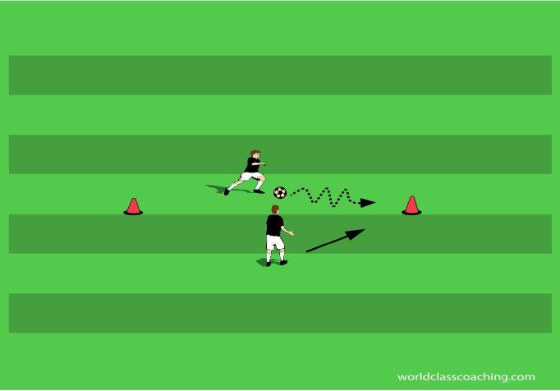
Two-Cone Dribbling - 6x15 yard grid
Players work in pairs with one soccer ball. The attacker starts midway between the two cones with the ball and facing the defender. Explain that the defender in this game must remain on her side of an imaginary line between the two cones (unless blocking a cone), and the attacker must also stay on her side of this line. To score, the attacker must dribble the ball to either cone and stop the ball in contact with the cone. To prevent the attacker from scoring, the defender must move back and forth and place herself between the attacker and the cone before the ball is put there. This game is a low-pressure (no tackling) environment where the attacking player should be encouraged to learn to change pace, direction, and dribbling surface frequently to try to wrong-foot the defender. Play for one minute and then change roles.
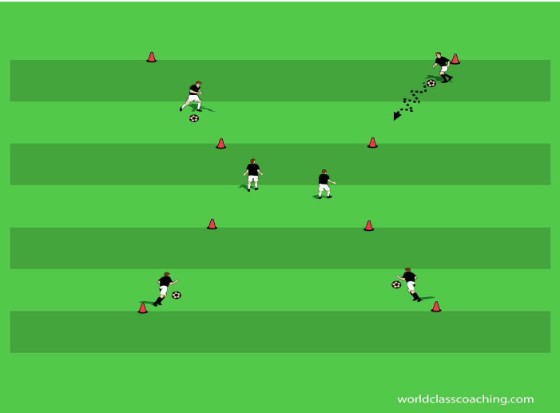
Hotbox - 15x15 yard grid with inner grid (5x5)
Two defenders begin in the hotbox. The other players are evenly distributed at 4 lines located six yards beyond the perimeter of the grid. The defenders must remain in the hotbox and they earn a point for each ball they kick out of the box while they are there. The dribblers must try to dribble toward the grid and then dribble around the cone nearest to their line (momentarily entering the grid) and exit the hotbox and dribble back to their starting point. If they are able to do this without losing their ball, they earn a point. If they lose their ball, then they retrieve it and get back in line. The next player in line then tries to score. The purpose of this game is to teach players how to deal with dribbling into tight space and when and how to time runs. They will learn to try to catch the defenders unaware and quickly get in and out. Play for two minutes and then change the defenders in the hotbox.
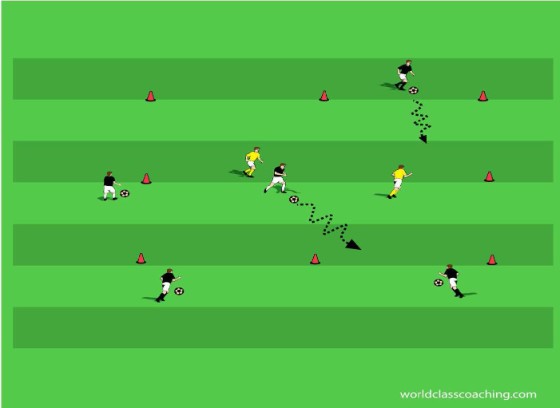
Alligator Alley - 12x20 yard grid
Select 2-3 “alligators.” These players do not have a ball and they stand inside the grid area. The rest of the team each need a ball and they spread around the perimeter of the grid. Explain that the goal of the game is to dribble across the “alley.” The alligators attempt to dispossess the dribblers as they cross the grid. The alligators earn one point for each ball they knock out of the grid. The dribblers earn one point for dribbling across the narrow width of the grid and three points for dribbling the long length of the grid. Players keep track of their points throughout the exercise. Rotate the alligators every two minutes and give every player the opportunity to be an alligator. This exercise is useful for encouraging players to engage in 1v1 duels, dribble to open space, execute sharp changes in speed on the ball, and learn to tackle.
Shark Attack - 20x20 yard grid
Select two sharks (1 for teams of 8 or less). All of the other players have a ball and dribble around the “shark tank” (the grid). The shark(s) run around the perimeter of the grid and then holler, “shark attack!” and charge into the grid. The sharks attempt to knock balls out of the grid. When a player loses her ball, she retrieves it and waits outside the shark tank. The coach should time the game to see how long it takes the shark to clear all balls from the tank. Select a new shark and see which shark requires the shortest time to clear the grid.
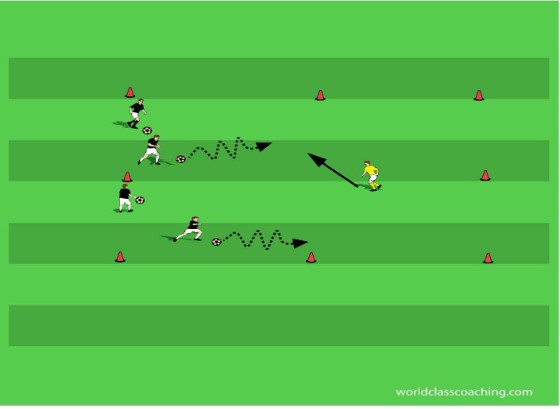
Wasteland - 15x20 yard grid
One player, the “fox,” is positioned in the middle of the grid (the wasteland) and the others all start on one end line. At a signal from the coach, the endline players attempt to dribble their balls across the grid to the opposite end of the grid. The fox attempts to kick as many balls out of the grid as possible. Any players losing their balls are stranded in the wasteland where they must join the fox in trying to dispossess the remaining dribblers on their next pass. Play until all players have have been dispossessed, and then play again with the game winner becoming the new fox. In this game, emphasize that good decision-making regarding when and where to run, as well as tight control of the ball, are critical to success.
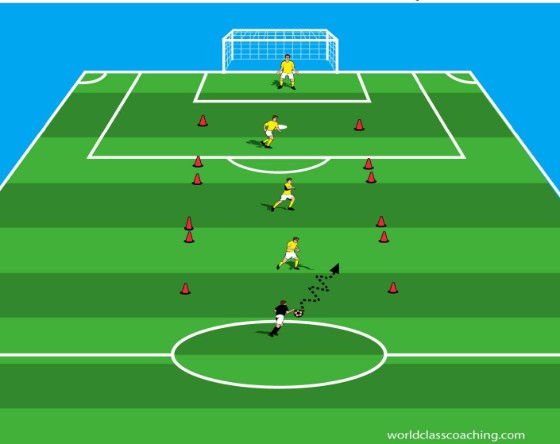
Angry Neighbor - 30x12 yard grid
Place a defender (angry neighbor) in each of the 3 10x12 yard grids. The remaining players should each have a ball and they line up at the end of the grid line. Explain that the goal of the game is to dribble the ball through the three “yards” past the the angry neighbors and then score by passing the ball into the goal at the far end. Whether a player is successful in getting through all three areas and scores, or if her ball gets knocked out of the grid by one of the angry neighbors, she then retrieves her ball and dribbles along the sidewalk (cone area on both sides of the grid areas) back to the line and the next attacker has a go. Play for three minutes and then change the defenders.
Crab Soccer – The Area Varies
There are several variations of this game and the size of the grid must be carefully adjusted to meet the needs of the players (i.e. it must be big enough to give the dribblers room to experience success and also small enough so that the “crabs” can apply pressure. In the standard version of the game, two “crabs” are set in the middle of the grid, with the rest of the players on the endline, each with a ball. The crabs must move around and remain in the “crab” position, on all fours (stomach up) and try to maneuver to kick the other players’ balls out of the grid each time the group is sent across the grid (on a signal from the coach). Players losing their ball join the crabs for the remainder of the game.
Variation
• Play to goal. Establish a safe-zone around the goal and then put the crabs in a coned area beyond the area. The dribblers are organized beyond these two areas and then attempt to dribble through the crabs before shooting from the safe area. Players losing their ball retrieve it and try again. Play for two minutes and then check scores before rotating the crab group.
1v1 Nutmeg! - 10X15 yard grid
Players work in groups of 4 with two players resting as “goals” on either endline. The two active players duel 1v1, attempting to win the ball and then dribble to their opponent’s endline and pass the ball between the legs of the resting player on that end. When the resting player is scored upon, she retrieves the ball and then changes roles with her partner (i.e. she becomes the attacker). It is important that endline players cooperate with attempts by players to pass the ball between their legs and transition quickly.
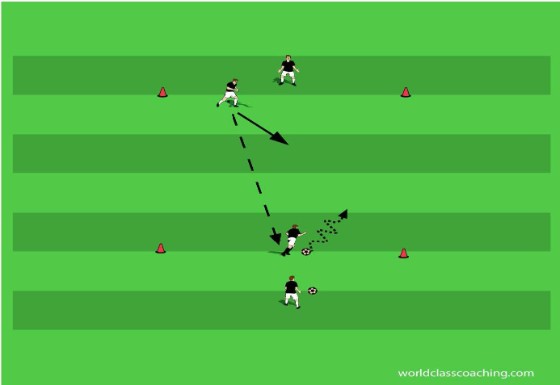
1v1 continuous - 10x10 yard grids
Organize players in groups of 4-6 per grid, with a ball supply at one end of the grid. Put an equal number of players in lines at each end of the grid. This is a simple, but very effective training environment designed to improve one vs. one play on both sides of the ball. Explain that the goal of the exercise is to dribble the ball over the opponents’ endline. Play is live as long as the ball remains inside the grid. The first player on the end where the balls are organized initiates re-starts by passing to the first player on the other end of the grid. These duels teach players how to deal with a defender in limited space, changing speed and direction on the ball, jockeying and tackling skills and much more. Play for two minutes and check scores. Be sure to have players switch lines after each duel.
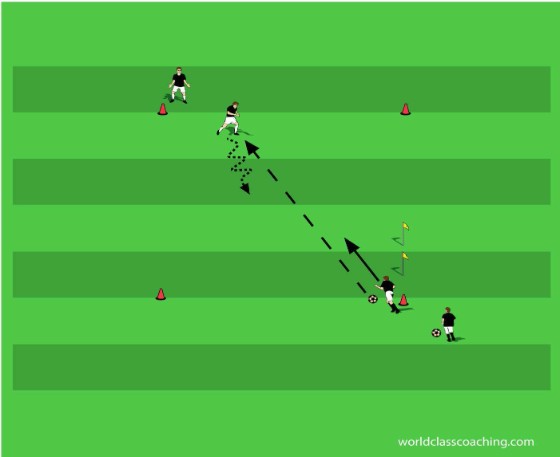
1v1 to a side cone goal - 10x10 yard grids
Organize players in groups of 4-6 per grid, with a ball supply at one end of the grid. Put an equal number of players in lines at each end of the grid. The lines are organized on opposite corners of the grid this time. Play is live as long as the ball remains inside the grid. The first player on the end where the balls are organized initiates re-starts by passing to the first player on the other end of the grid. These duels teach players how to deal with a defender in limited space, changing speed and direction on the ball, jockeying and tackling skills and much more. The side cone goal can be used to introduce the idea of “goal side,” which is a reference to the need for the defender to stay between the ball and the goal. If the defender wins the ball, she still attempts to dribble out her opponent’s end of the grid for a point. For the attacker, she must now consider how to attack a more limited space and goal. After each duel, players change ends. Play for two minutes and check scores.
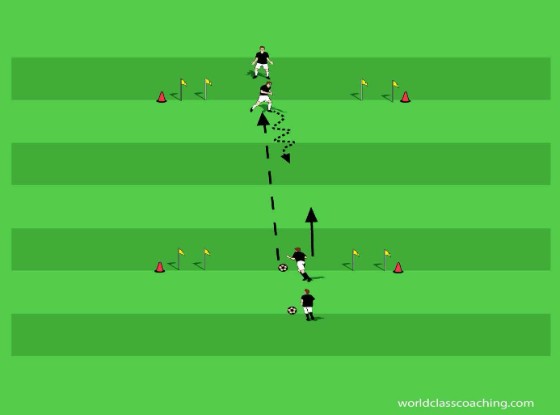
1v1 to 4 goals - 15x15 yard grids
Organize players in groups of 4-6 per grid, with a ball supply at one end of the grid. Put an equal number of players in lines at each end of the grid. This is a simple, but very effective training environment designed to improve one vs. one play on both sides of the ball. Explain that the goal of the exercise is to dribble the ball through either of the the oppo-nents’ cone goals. The presence of two goals encourages players to change directions. Play is live as long as the ball remains inside the grid. The first player on the end where the balls are organized initiates re-starts by passing to the first player on the other end of the grid. These duels teach players how to deal with a defender in limited space, changing speed and direction on the ball, jockeying and tackling skills and much more. Play for two minutes and check scores.
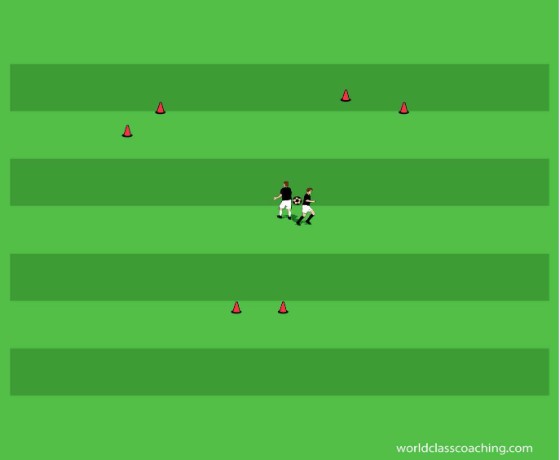
1v1 back-to-back to three goals - 12x12 yard area
Here, the players start back-to-back with a ball trapped between their lower back areas. At a signal from the coach, they let the ball drop and a duel ensues, with the goal being to dribble the ball through any of the three cone goals. Keep track of points and frequently rotate partners.
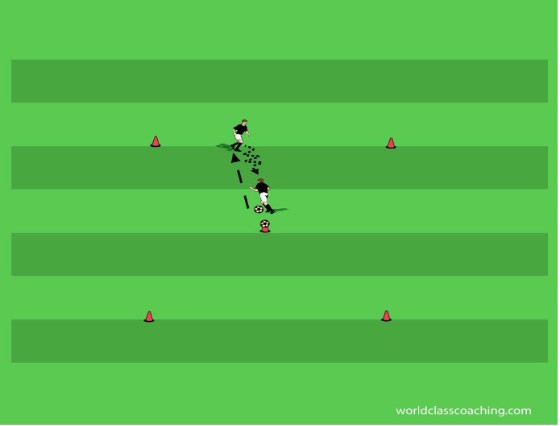
1v1 to a cone/ball goal - 10x10 yard grids
Players work in pairs in 10x10 yard grids with two balls. Place one ball on top of a disc cone and give the other ball to one player. The attacker can start play anywhere on the perimeter of the grid. The attacker attempts to dribble the ball past the other player, who is the defender, and use her ball to knock the other ball off of the cone. Each time she does this, she earns a point. If the defender wins the ball, she must dribble to the perimeter of the grid and restart play and the roles change. Play for three minutes and check scores. It is important that the coach encourage the defender to come out and challenge the attacker and not just wait by the cone.
1v1 to two cone/ball goals - 12x12 yard grids
Here there are two cone goals and the attacker can attack either goal. Again, the presence of multiple goals encourages the attackers to change directions and also make good decisions on the dribble. When a point is scored, the attacker recovers the ball to the cone/ball goal while the defender goes to the perimeter with a ball to restart play.
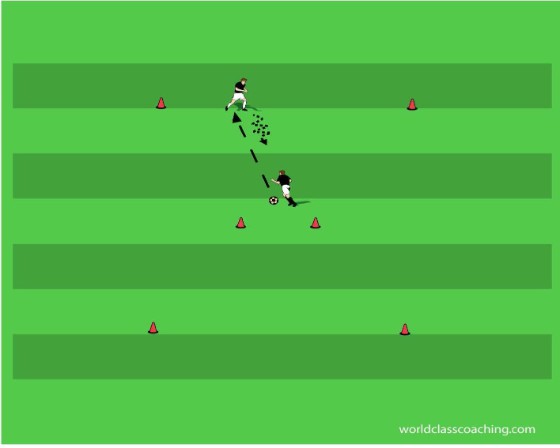
1v1 to a central goal - 10x10 yard grids
Players work in pairs in 10x10 yard grids with one ball for each pair. The attacking player starts on the edge of the grid and the defender must come out and challenge the attacker, who tries to beat her on the dribble and run the ball through the central cone goal. If a goal is scored, the players change roles and play re-starts. If the defender wins the ball, she tries to dribble over the perimeter of the grid and the players change roles for play to re-start. This latter restriction teaches players to recognize transition in the game. Play for three minutes and check scores.
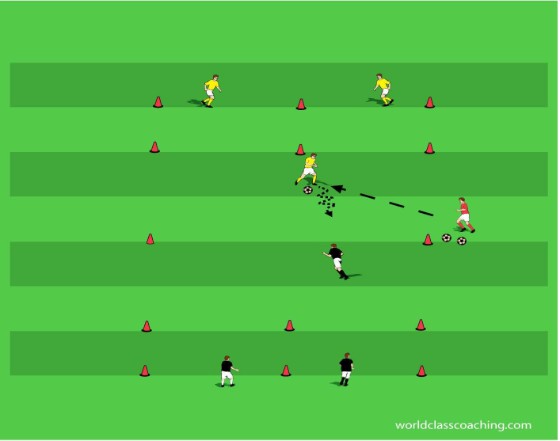
1v1 Zone Soccer - 15x12 yard area
Divide the group into 2 teams. Each team has a set of colored vests and occupies an endline. The grid has two end zones as noted in the diagram. The coach has a ball supply and stands at the side of the grid, where he calls the name of a player from each team to enter the grid and duel. The coach should then serve a ball to the middle area of the grid. The players duel for possession, and then work to dribble the ball into the opposing team’s end zone and step on the ball to earn a point. If the ball leaves the area or after a point is scored, the players return to their respective endlines and a new duel begins.
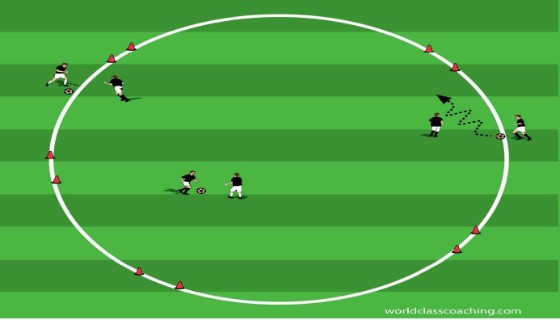
1v1 Center Circle Dribbling - center circle
Create five cone goals around the circumference of the center circle. Players work in pairs with one soccer ball. One partner is on the inside of the circle, prepared to defend. The other partner, the attacker, is on the outside of the circle with the ball. The entire team plays at once. Explain that the attacker can only score points by entering the circle (at any point) and then exiting through one of the goals (dribble). Only the attacker’s partner can defend the attacker. If the defender wins the ball, she tries to dribble through a goal and earn a point for herself. If the ball is knocked out of the circle, the players change roles (the defender retrieves the ball and becomes the attacker). Play for five minutes and check scores.
Many balls - full field
Play a standard scrimmage to two goals and with two teams, but use two balls at once. Teams can score in either goal. When a ball leaves the area, the coach serves another ball onto the field so that two balls are always active. This game encourages players to avoid bunching and also tends to create room for individual attacking to goal.


